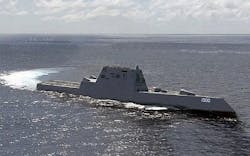Navy weapons, network warfare, smart munitions, and laser weapons are top reader trends in 2017
Other technology trends in which our readers were most interested this year, based on page views to the Military & Aerospace Electronics Website, include the nearing deployment of laser weapons, smart bullets and other smart munitions, ballistic missile defense, the ability to swarm unmanned aircraft, and new capabilities among U.S. adversaries.
The single most-read story of 2017 is about new technologies in anti-missile warheads -- each one able to destroy or disable several incoming enemy missiles on its own.
The story, headlined Boeing, Raytheon, and Lockheed Martin set to develop ballistic missile defense multi-warhead killer, involves a project to develop ballistic missile defense multi-warhead killers each able to that detect, track, and kill several incoming enemy missile warheads and decoys.
The project, sponsored by the U.S. Missile Defense Agency (MDA), is called the Multi-Object Kill Vehicle (MOKV) technology risk reduction effort. It's designed to engage several incoming objects simultaneously with kill vehicles that communicate with one another to destroy several incoming warheads and decoys using advanced sensor, divert and attitude control, and communications technologies.
Related: At long last, laser weapons are nearing deployment
Ultimately only one of the three contractors will move forward to build and deploy the MOKV multi-warhead killer.
Another popular story this year, headlined Sailing ships to nuclear submarines: get ready for another disruptive shift in naval warfare, is about real-time secure networks of manned and unmanned aircraft, surface ships, and submarines able to attack and defend vast areas of the world's oceans to hold enemy ships and submarines at risk over wide contested areas.
It involves the Cross Domain Maritime Surveillance and Targeting (CDMaST) project of the U.S. Defense Advanced Research Projects Agency (DARPA). This effort could augment aircraft carrier battle groups and manned submarines with networked manned and unmanned systems of systems (SoS) that work collaboratively to control the seas -- and possibly render previous forms of naval warfare obsolete.
The CDMaST program seeks to move away from a centralized defensive aircraft carrier battle group posture to a more distributed and agile approach to hold the opponent at risk over ocean areas as large as a million square kilometers.
Trends in naval weapons technology, however, is about more than just network-centric maritime operations. The Navy also is at the forefront of laser weapons technologies to defend surface warships from swarms of unmanned aerial vehicles (UAVs), small manned and unmanned attack boats, and even incoming aircraft and missiles.
Readers also are interested in enabling technologies for smart munitions that not only could extend the range of naval shipboard guns, but also lead to a next-generation long-range anti-ship missile designed to penetrate even the most sophisticated defenses.
Smart munitions technology extends beyond the Navy's Long-Range Anti-Ship Missile (LRASM). Readers in 2017 also flocked to a story headlined Military closer to developing smart bullets for machine guns on ships, vehicles, and aircraft about the DARPA Multi Azimuth Defense Fast Intercept Round Engagement System (MAD-FIRES) program to enable machine gun bullets to home-in on their targets, with even the ability its change their paths in mid-flight to engage rapidly maneuvering targets.
With this, researchers envision a weapon that offers the rapid-fire capability of a machine gun with the precision independent targeting of a guided missile, and develop enabling technologies to fire smart bullets rapidly at separate targets like swarms of manned and unmanned aircraft, fast attack boats, quickly maneuvering land vehicles, or other massed attacks.
Ready to make a purchase? Search the Military & Aerospace Electronics Buyer's Guide for companies, new products, press releases, and videos
